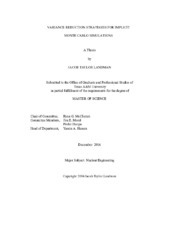| dc.description.abstract | The thermal radiative transfer equations are extremely complex to solve; however, accurate solutions are necessary for problems concerning inertial confinement fusion and radiation hydrodynamics (e.g. supernova explosions). A method known as Implicit Monte Carlo (IMC) is widely used among the scientific community to solve such problems; however, the slow convergence of Monte Carlo methods can result in exhaustion of computational resources and statistically inaccurate solutions for very complex simulations. Thus, methods must be developed to decrease the uncertainty in our results without exhausting our resources.
In this work, we developed, tested, and analyzed two methods that aim to reduce uncertainty and increase the efficiency of the IMC method. The first method intends to remove an anomalous heating phenomenon that can occur from the clash of mesh effects, geometric convergence, and Monte Carlo noise. We were able to successfully eliminate the abnormal heating, but only at the cost of decreased numerical accuracy.
The second method utilized a very efficient approach for obtaining a center value for the widely used Monte Carlo variance reduction method known as weight windows. With weight windows, particles whose weights are above the weight window are split into additional average-weight particles, and particles below the weight window undergo Russian Roulette to increase the computational efficiency. Our approach utilized the previous time step’s intensity as the weight window center, resulting in a higher Monte Carlo efficiency for problems containing optically thick materials where the radiation intensity changes very slowly. Problems containing optically thin materials performed as expected and conditions were added to allow for increased Monte Carlo efficiency for problems containing a mix of thick and thin materials. However, we have recently discovered an issue that may allow thermal energy to travel too far. Near the interfaces between thick and thin materials, our method introduces an unphysical heat up resulting in inaccurate material temperatures. | en |


